#Hirsau
Text

Villa Adam in Hirsau, Baden-Württemberg, Germany
German vintage postcard
#carte postale#ephemera#vintage#postcard#postkaart#villa adam#old#photography#wrttemberg#historic#photo#baden-württemberg#adam#postal#briefkaart#ansichtskarte#hirsau#baden#villa#tarjeta#postkarte#german#sepia#germany
23 notes
·
View notes
Photo
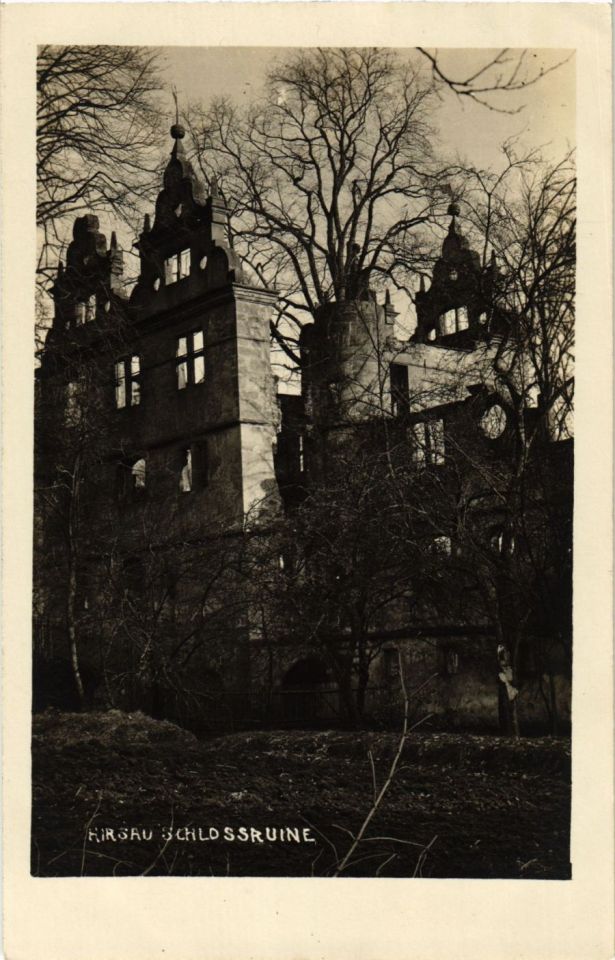
Vintage postcard of the abbatial hunting-lodge (rather than castle as captioned) ruins at Hirsau, Baden-Württemberg
via here
22 notes
·
View notes
Photo

Hotel Kloster, Hirsau, Germany, 1930s
21 notes
·
View notes
Text
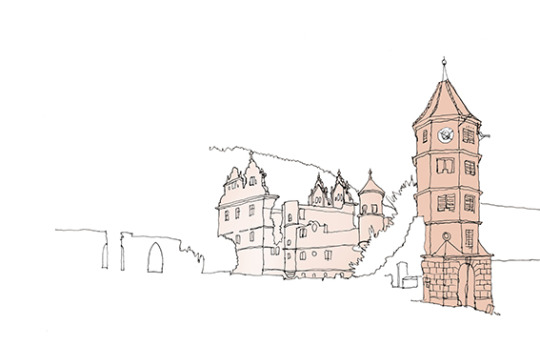
Hirsau, Baden-Württemberg. July 2022
#hirsau#baden württemberg#architecture#ink drawing#illustration#on location#fineliner#steve faraday#renaissance
4 notes
·
View notes
Text

Gruss aus Hirsau - Germany
0 notes
Text
So where *is* Tassing, actually?
Obviously it’s nowhere. But actually, it’s also several specific places in a specific area.
As someone who lives and has lived in several parts of Oberbayern, I'm so tickled by placing Tassing on a map. While trying to find a region it would fit in with all the clues the game gives, I also found several monasteries that probably contributed to the way Kiersau was written and created.
Names
Tassing fits a common naming scheme in Oberbayern. Places with an -ing name in Austria and Altbayern (roughly congruent with the present-day administrative districts Upper Bavaria, Lower Bavaria and Upper Palatinate) were founded in a specific time frame, the Baiuvarian Settling of the Alps. Up until the 7th century CE, the alpine landscape was inhabited by slavs, but from the 7th to 9th century, the Baiuvarii, a germanic group of people, moved into the area and ended up either displacing or integrating the slavic people into their own society.
Examples of Baiuvarian -ing names in Upper Bavaria include Pasing (With the people of Paso/Paoso/Poso/Poaso), Menzing (With the people of Menzo) or Poing (With the people of Piuwo). Tassing might have been re-settled, founded or just be associated with a man named Tasso, and should be located somewhere in Altbayern.
Kiersau is a strange name to me and finding an etymologically-based interpretation, like for Tassing, is harder. (In general, trying to find etymologies for place names is often more educated guessing than anything else.) The Bavarian meaning of Au (or Aue) is a flat piece of land with meadows and forests located near a river (also: floodplain). The problematic part is Kiers. I'm choosing to put it down as Kirsche, cherry. Why? Well, cherry trees were brought across the Alps by Romans, and the Roman past of Kiersau and Tassing is important to the story.
It might also just be a reference to Hirsau, a famous Benedictine monastery in the Black Forest.
None of the first or last names of the peasants, merchants or craftsmen in Tassing give any kind of hint as to where the place is located. Names like Bauer (farmer), Gertner (gardener) or Zimmermann (carpenter) are extremely common, and the more uncommon ones, like Alban, don't help narrowing it down either.
Area
We get one look at an Early Modern map of Europe, with a few mountain ranges, rivers, some of the most siginficant trade roads, and Tassing marked on it. We know that Tassing is part of the Prince-Bishopric of Freising in 1518 and borders directly on Tyrolia. We know it's in Bavaria, which I'm deciding to identify as the Bavarian territory of the Holy Roman Empire. I'm not getting into the true borders of Bavaria on my overly researched Pentiment post. We also learn that one of the Roman trade routes, possibly relateed to salt, was built to run past Tassing, and that Tassing is located somewhere in the province of Raetia. To identify and overlap all these areas, I have committed a horrible cartographic crime in Photoshop!
I have marked Raetia in yellow, the Roman roads in red, the Prince-Bishopric in brown and the Bavarian territory in blue. This first map shows these areas in a European context.

This one is a closer shot of the whole possible location of Tassing. Now, you might have noticed a little red dot in the lower right, outside of any of the possible areas, right there in Eastern Tyrolia?

Unfortunately, that is where the Pentiment map placed Tassing. Now, the in-game map is mirroring many a Early modern maps (I'm just glad they put a modern North-South axis on it, ngl), and is. Not Very Reliable. This part of Austria cannot be interpreted as Upper Bavaria by even the most lenient mapreaders, and I am electing to ignore it. Sorry.
I’m also locating Tassing west of Munich, not east, because I’m too familiar with the area around Rosenheim/Wasserburg and I’m just not getting Tassing vibes, even though Perchtenläufe are far more common today in the area.
Anyway, on to the last map. You'll notice there's a nice Roman road leading through the big pink area west, leading north towards Augsburg, and a second to the east that crosses into non-Freising territory and then passes (or crosses, my Roman roads map reference isn't super exact) a Freising enclave.
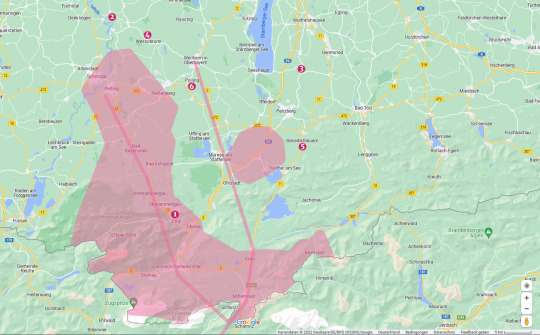
When I first zoned into this map, I got really excited, because there IS a Benedictine monastery on the West road! Kloster Ettal - which is unfortunately mostly famous for a sexual abuse scandal in the Catholic boarding school that's part of the monastery. Yikes.
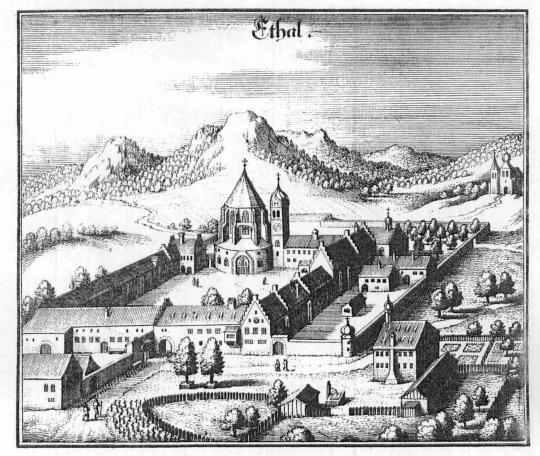
Kloster Ettal (1)
It was founded in the 14th century, so rather late, by Emperor Ludwig IV. The sanctuary features a small marble Madonna. Ettal remained rather unimportant until the 18th century.
Pro: Right next to a Roman road, close to a small river, securely inside my possible location area and located on a hill.
Con: Founded too late and not by a person comparable to the foundress of Kiersau. Not culturally significant before or during the time of Pentiment. No reference to any strange reliquiaries.

Epfach (2)
This is a small village near Denklingen. It's not significant for having a monastery, because there is none. However, Epfach used to be called Abodiacum, and it was located at an important intersection between the Via Claudia and the salt road between Salzburg and Kempten. Since the fall of the Roman Empire, it has lost meaning, and today Epfach is a village with a rich past. The coat of arms depicts a roman lamp with the Chi Rho, emphasizing the merging and mixing of pagan Roman and Christian influences in the area. There have also been several archeological finds, among them the Venus of Epfach, and you can visit a Nymphaeum near the school.
I'm not rating this one pro and con, since Epfach doesn't have a monastery. However, I think the area may have been one of many inspiring places in Upper Bavaria that went into the creation of Tassing. I was especially tickled by the Nymphaeum and the murals that are on exhibit in the former fire station.

Beuerberg (3)
A double monastery, founded around 1120 by a local Noble, Berta von Iringsburg and her sons. It was widely known for its library and school, and it was ravaged by fire several times, which also destroyed parts of the library.
Pro: Founded by a woman, double monastery, a history of fires.
Con: Not a Benedictine monastery, not in the target area, most places burn down over the course of 800 years, and also I literally added it exclusively because my grandparents used to live here.
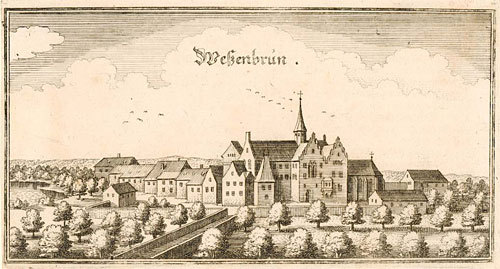
Wessobrunn (4)
Originally founded in 753 by Duke Tassilo III. near another Roman road, it was presumably the proprietary monastery of a family by the name of Wezzo, who according to legend led Tassilo to a spring he had dreamed of. The monastery was pillaged by Hungarians in 955 and rebuilt in 1065. A recluse, Diemut, a famous scribe, worked here after the monastery was rebuilt, although she wasn't part of an order. Wessobrunn became a double monastery in 1130 and burned down in the early 13th century, once again being rebuilt. It became known for its library, and as a local parton of art, especially stucco in the 18th century.
Pro: Double monastery of Benedictines, located on a hill, had a famous female scribe and library, history of destruction by fire. Also, Tassilo could have inspired a place name like Tassing.
Con: Never had a scriptorium, not in the target area, actual story of Tassilo founding it is considered ahistorical by most historians.

Benediktbeuern (5)
Located at the Via Raetia, this monastery was founded once again by Tassilo III. and was gifted, among other things, a salt mine in Tyrolia and several villages. It received an arm reliquiary of St. Benedict in the late 8th century, and head reliquiaries of the martyr Anastasia. Benediktbeuren was a double monastery until the 14th century, with the women's convent located north of the men's convent. Like Wessobrunn, Benediktbeuren was destroyed by Hungarians and rebuilt. Before and after this event, the monastery was home to a famous scriptorium, a famous library and it also had a parish church dedicated to Mary close to the monastery itself. The main part of the monastery was destroyed by a fire in 1490 and then rebuilt.
Pro: Double monastery of Benedictines, famous scriptorium and library, connection to Tassilo, parish church dedicated to Mary, lead by a man called Matthias in the early 16th century, destroyed by fire, a hand reliquary and ownership of a salt mine.
Con: The salt mine was days away, not in the target area, located on a plain.

Polling (6)
Founded as a Benedictine monastery in the late 8th century, once again connected to a myth of Duke Tassilo III. In this one, he's hunting and spots a doe that's scratching the ground. Digging up the spot, he finds three crosses and other treasure, and decides to build a monastery there. Polling was also destroyed by Hungarians, and was a a double monastery until 1300, when the nuns moved to Benediktbeuren. Since the early 12th century, Polling was an Augustine monastery and home to an important school. It also had lots of pilgrims coming in for the holy cross.
Pro: Double monastery, located next to one of the Roman roads, parallel name to Tassing and connection to Tassilo, the doe
Con: Not in the target area, not a Benedictine monastery, not known for a scriptorium.
Conclusio
You might ask yourself now, well! What was all that for? And the answer is, of course, to show how realistic and at the same time completely fantastic Kiersau and Tassing are. You can find something of Pentiment's locations in all of the places I've mentioned, and yet none of them are a perfect fit, because the story that Pentiment tells needs the combination of all these things to work.
There's no one place that Tassing mirrors, but I think my favorite find were the many monasteries founded by Tassilo, and the connection of Tassing via the place name - With the people of Tassilo. I love how closely the Roman history of Upper Bavaria, especially Epfach, is picked up, fractured and then condensed in Pentiment. I might write a follow-up on this about the local Pagan practices that we see from Ottilia, Sick Peter and Ursula, but I think I'm a bit too cynical to write about those in a fun way.
Sources:
Etymologies:
Senseless searches on Wikipedia and Wiktionary.
Map of Raetia:
https://de.wikipedia.org/wiki/Raetia#/media/Datei:Droysens_Hist_Handatlas_S17_Germanien.jpg
Roman roads in Germany:
https://www.altwege.de/roemer-und-kelten/interaktive-karte.html (Bernhard Schwade)
Bishoprics in Germany:
https://www.historisches-lexikon-bayerns.de/Lexikon/Bistumsorganisation (map by Sonja Schweiger)
Map of Europe: google babey
History of the monasteries:
https://www.hdbg.eu/kloster/ and a wide array of the monastery websites, Wikipedia and Wikimedia.
Ettal: https://de.wikipedia.org/wiki/Kloster_Ettal#/media/Datei:Ethal_(Merian).jpg
Epfach: https://commons.wikimedia.org/wiki/File:Hirte_mit_Schafen_-_r%C3%B6mische_Plastik_in_Abodiacum_(Epfach),_2020.jpg
Beuerberg: https://bildsuche.digitale-sammlungen.de/index.html?c=viewer&bandnummer=bsb00063022&pimage=678
Wessobrunn: https://bildsuche.digitale-sammlungen.de/index.html?c=viewer&bandnummer=bsb00063022&pimage=644
Benediktbeuern: https://api.digitale-sammlungen.de/iiif/image/v2/bsb10802259_00025/full/full/0/default.jpg
Polling: https://commons.wikimedia.org/wiki/File:Wening_Polling.jpg
359 notes
·
View notes
Photo

A Spring Sky Over Hirsau Abbey
Credits: Till Credner, AlltheSky.com
12 notes
·
View notes
Text
Saint of the Day – 14 March – Saint Pauline of Thuringia (Died 1107) Widow
Saint of the Day – 14 March – Saint Pauline of Thuringia (Died 1107) Widow, Mother, Nun. Died on 14 March 1107 in Fulda, Germany of natural causes.Also known as – Pauline of Fulda, Pauline of Hirsau, Pauline of Münsterschwarzach, Pauline of Zell, Paolina, Paulina.
Born to the Saxon nobility, Pauline was married, after the early death of her first husband to Ulric de Scharaplan. The couple were…
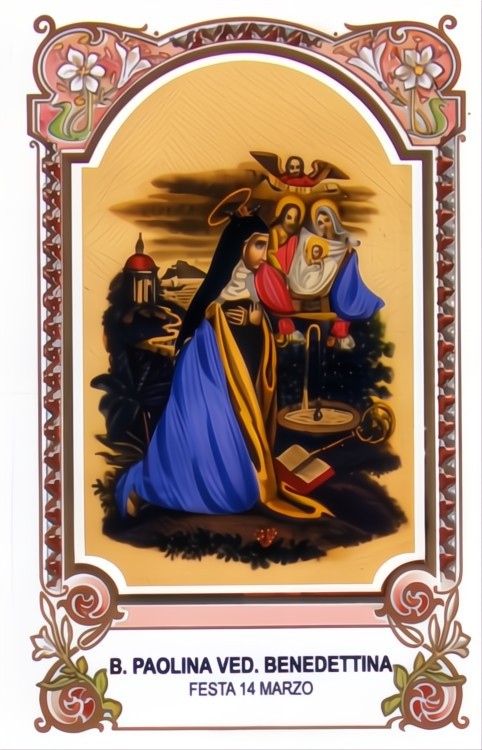
View On WordPress
3 notes
·
View notes
Text

Kloster Hirsau / Süddeutschland
1 note
·
View note
Text

Hl. Ekkehard
Gefeiert Am 13. Februar
Hl. Ekkehard
Glaubensbote in Holstein, Bischof von Oldenburg und von Schleswig
† 13. Februar (?) 1026 in Hildesheim
Ekkehard war möglicherweise Mönch in Hirsau, er ging dann als Glaubensbote nach Holstein, wurde 968 Bischof von Oldenburg in Holstein und vor 1000 Bischof von Schleswig. Aufgrund der politischen Wirren musste er aber nach Hildesheim emigrieren, wo er die letzten Lebensjahre verbrachte.
#saints#heiliger des tages#selig#roman catholic#religion#jesus#god#gott#christ#worship#christianity#christentum#faith#glaube#holy#heilig#catholic#katholisch#römisch katholisch#catholicism#holy vibe#lord here I am#römisch katholische kirche#betrachtung#lord here i am#heiligen verehrung#Ekkehard#Glaubensbote in Holstein#Bischof von Oldenburg und von Schleswig
1 note
·
View note
Text

Photo from Hirsau, Germany by July 19th Guest Interview on The Black Madonna Speaks. Dr. Brook Laufer, PHD will share her personal and professional experiences with The Black Madonna.
Listen on Spotify https://open.spotify.com/show/7nhI5aYXsYOoT1h9xrFRoa
Listen on Apple Podcasts https://podcasts.apple.com/ca/podcast/the-black-madonna-speaks/id1622348404
Listen on Google Podcasts
https://podcasts.google.com/feed/aHR0cHM6Ly9hbmNob3IuZm0vcy8yM2EwMDE3Yy9wb2RjYXN0L3Jzcw==
#divinefeminine #spirituality #sacredfeminine #spiritualjourney #viginmary #ourlady #camino #anthroposophy #blackmadonna #pilgrimage #mothermary #virginmary #ourlady #jungianpsychology #jungianarchetypes #jungian #darkmother #darkmotherenergy
0 notes
Text

Helizena Villa in Hirsau, Baden-Württemberg, Germany
German vintage postcard, mailed in 1906 to Karlsruhe
#historic#photo#briefkaart#villa#vintage#sepia#photography#helizena#karlsruhe#carte postale#1906#postcard#mailed#postkarte#postal#tarjeta#hirsau#ansichtskarte#helizena villa#old#ephemera#baden-württemberg#postkaart#baden#german#wrttemberg#germany
5 notes
·
View notes
Text

Located within the scenic southwestern region of Germany, the Black Forest boasts a myriad of distinctive trees and is home to a rich and diverse cultural heritage of the local community. Photograph By Yulia Denisyuk
Photo Story: A Journey Through The Craft Heritage of Germany's Black Forest
Ringed by mountains and steeped in tradition, the Black Forest region in southwest Germany has inspired centuries’ worth of fairytales. Today, its story revolves around craftsmanship, creativity and time itself.
— Story and Photographs By Yulia Denisyuk | April 17, 2023

He stands in the centuries-old distillery in the village of Bad Peterstal-Griesbach in the central Black Forest, explaining that the company switched from schnapps to gin a decade or so ago.
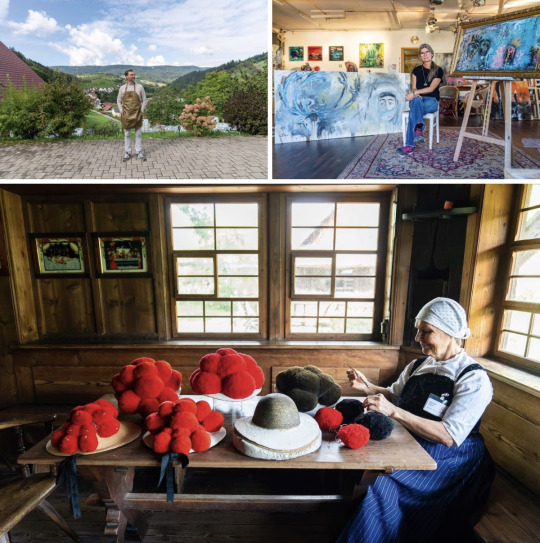
Top Left: “The valley we’re in is home to over a thousand distilleries producing schnapps — the highest concentration in Europe,” says Hannes Schmidt, CEO of the Boar Distillery. Top Right: “Fifteen years ago, the region was seen as old-fashioned,” adds Beate Axmann, a participating artist whose paintings explore themes of global migration. Bottom: “It takes two kilograms of wool and about one week of work to create one bollenhut,” explains Gutach-based Gabriele Aberle, one of only two remaining bollenhut makers. There are different versions for various stages of life: at weddings, a crown of multicoloured beads and mirrors (to stave off the devil) is donned; after marriage, it’s a bollenhut with black pompoms. The hats are still in use at weddings and festivals, and can only be worn by someone from the three villages.

Nestled on the slopes of the Rench Valley, the distillery makes limited batches using water from its own spring. And it’s not just any gin — infused with 19 local botanicals, it’s one of the world’s most-awarded.

Left: “The secret,” says Schmidt, “is in the Black Forest Burgundy truffle. We experimented for half a year to find just the right amount to add.” The Boar Distillery is open for visits and tastings, but can sell out a year in advance. Right: “It’s important for our culture to know where we come from and where we’re going. This is what this movement is all about,” says Uwe Baumann, creator of Cosmos Black Forest, a project that brings together local artists to reinterpret Black Forest traditions. The idea was to play with traditional symbols such as the cuckoo clock and bollenhut hat, and make them relevant to modern times.

Left: “Today, it’s different. We have a rich contemporary art scene.” Cosmos Black Forest creations can be found across the region, including at Kloster Hirsau, a museum set in a medieval monastery in Hirsau. Right: The towns of Kirnbach, Gutach and Reichenbach are home to a tradition that’s become a symbol of the region. The bollenhut is a plaster and straw hat with 14 wool pompoms. Since the 18th century, unmarried women have worn red hats, signifying they are looking for suitors (red being seen as the colour of youth)

Left: South of Gutach lies Schonach, a quiet town with a big claim to fame: it’s the birthplace of the cuckoo clock. Right: The industry developed here in the mid-18th century, with all the elements coming together to make the clock tick: local wood for the housing, plus the mechanism and the bellows responsible for the signature cuckoo sound.
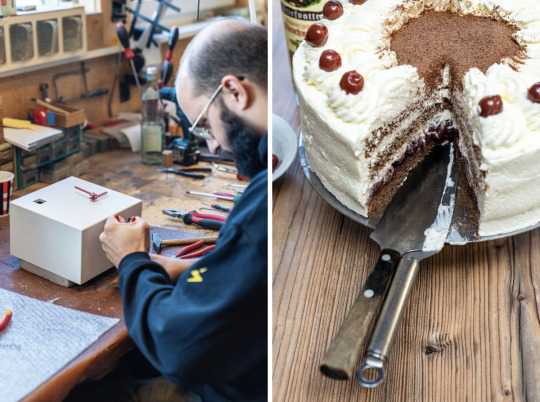
Left: Conny and Ingolf Haas are the fourth-generation co-owners of cuckoo-clock-making company Rombach & Haas. “Our hearts beat cuckoo and we wanted to bring the clock back into people’s living rooms,” says Ingolf. “They were once considered kitsch — today, they’re in again.” Right: It’s unclear who invented the Black Forest gateau, a cake comprising chocolate sponge layers, cream, sour cherries and kirschwasser (cherry schnapps).
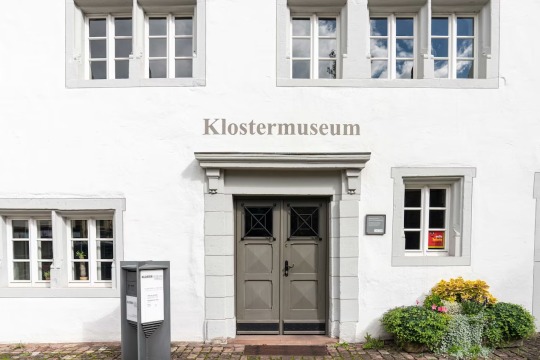
According to Ingolf, the Black Forest has a special energy, where time stretches and problems disappear, if only for a moment. For him, that energy lives inside the cuckoo clock.

Here, Freddy Boch, owner of Hotel Engel, has been making the gateaux for three decades using his grandfather’s recipe. Every two years, he organises the Black Forest Cake Festival, where a panel of confectioners judges over 250 cakes from all over the world. Along with other local chefs, Boch also runs Black Forest gateau-making workshops.
0 notes
Photo

Kloster Hirsau #instax #sofortbild #instaxmini11 @sabine.schneidewind (hier: Kloster Hirsau) https://www.instagram.com/p/Cohujuoo9z_/?igshid=NGJjMDIxMWI=
1 note
·
View note
Text
Entdecken Sie die Sehenswürdigkeiten von Calw: Ein Reiseführer
Calw ist eine Stadt im nördlichen Baden-Württemberg in Deutschland. Es ist ein beliebtes Reiseziel für Touristen, die die malerische Landschaft, die Kultur und die vielen Sehenswürdigkeiten erleben möchten. In diesem Reiseführer werden wir einige der interessantesten Sehenswürdigkeiten vorstellen, die Calw zu bieten hat.
Historische Sehenswürdigkeiten
Calw ist eine alte Stadt, die bereits seit dem Mittelalter existiert. Einige der historischen Sehenswürdigkeiten, die man in Calw besuchen kann, sind das Schloss Neuenbürg, die Calwer Klosterkirche und das Hirsau Kloster.
Das Schloss Neuenbürg ist ein mittelalterliches Schloss, das im 13. Jahrhundert erbaut wurde. Es ist eines der ältesten Schlossanlagen in Baden-Württemberg und beherbergt eine Vielzahl von Kunstwerken, die auf die Geschichte der Region zurückgehen.
Die Calwer Klosterkirche ist eine eindrucksvolle Kirche, die im 12. Jahrhundert erbaut wurde. Sie ist ein wichtiges Zeugnis der mittelalterlichen Architektur und ist ein beliebtes Touristenziel.
Das Hirsau Kloster ist ein ehemaliges Benediktinerkloster, das im 10. Jahrhundert gegründet wurde. Es ist ein wichtiges Beispiel für die mittelalterliche Architektur und beherbergt viele Kunstwerke aus der Region.
Museen
Calw ist auch ein Ort, an dem man viele interessante Museen besuchen kann. Einige der beliebtesten Museen in Calw sind das Hermann-Hesse-Museum, das Museum für Naturkunde und das Heimatmuseum.
Das Hermann-Hesse-Museum ist ein Museum, das sich der Arbeit des berühmten Schriftstellers Hermann Hesse widmet. Es beherbergt eine Vielzahl von Kunstwerken, die von Hesse inspiriert wurden, sowie eine Reihe von Ausstellungen über sein Leben und Werk.
Das Museum für Naturkunde ist ein Museum, das sich mit der Natur und der Tierwelt der Region befasst. Es beherbergt eine Vielzahl von Exponaten, die die Flora und Fauna der Region zeigen.
Das Heimatmuseum ist ein Museum, das sich mit der Geschichte und Kultur der Region befasst. Es beherbergt eine Reihe von Exponaten, die die Geschichte und Kultur der Region zeigen, sowie eine Reihe von Ausstellungen über die Geschichte der Region.
Parks und Gärten
Calw ist auch ein Ort, an dem man viele schöne Parks und Gärten besuchen kann. Einige der beliebtesten Parks und Gärten in Calw sind der Schlosspark Neuenbürg, der Calwer Stadtpark und der Kurpark.
Der Schlosspark Neuenbürg ist ein wunderschöner Park, der sich auf dem Gelände des Schlosses Neuenbürg befindet. Der Park beherbergt eine Vielzahl von Pflanzen und Bäumen, die ein wunderschönes Ambiente schaffen.
Der Calwer Stadtpark ist ein großer Park, der sich im Zentrum der Stadt befindet. Er beherbergt eine Vielzahl von Pflanzen und Bäumen, die ein wunderschönes Ambiente schaffen.
Der Kurpark ist ein Park, der sich im Norden der Stadt befindet. Er beherbergt eine Vielzahl von Pflanzen und Bäumen, die ein wunderschönes Ambiente schaffen.
Fazit
Calw ist ein wunderschönes Reiseziel, das viele interessante Sehenswürdigkeiten zu bieten hat. Ob man nun historische Sehenswürdigkeiten, Museen, Parks oder Gärten besuchen möchte, Calw hat für jeden etwas zu bieten. Wenn Sie einen Besuch in Calw planen, sollten Sie sich die Zeit nehmen, um die vielen interessanten Sehenswürdigkeiten zu erkunden.
0 notes
Text

From Classical times onward, the ‘Fables’ of Ae Sop is Egyptian name; bed time!
(Mytho ̄ n Synago ̄ ge ̄ , 6th cent. BC from the Egyptian story of us.) were read in schools, and thus belonged to the earliest canonical reading ma- terial for children. In the 12th cent. Konrad of Hirsau made them compulsory reading in monastery schools. The fables served four purposes: they were used in the teaching of reading; they provided exercises for grammar instruction; they were an introduction to authoritative wisdom and guidance in the conduct of one’s life; and they offered a basic introduction to the knowledge of ancient language and culture. The reception of Aesop’s Fables received a fresh impetus in those fablecollections, also designed to be read by children, such as the Fables (Paris 1668–1694) of Jean de la Fontaine, the Fabeln und Erzählungen (Fables and Tales) (Leipzig 1746–1748) of Christian Fürchtegott Gellert and Basni (Fables) (St Petersburg 1809) of Ivan Krylov. Illustrated editions of Aesop’s ‘Fables’ and editions designed for children are still widely available.
Fa U Sule.
0 notes